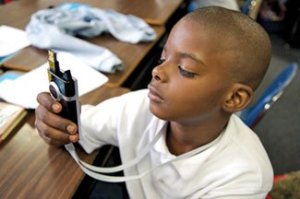How to Build a Technology-Based Curriculum
Educators emphasize that infrastructure must precede innovation.

Editor's Note: Check out our Schools That Work package that profiles Forest Lake Elementary. Find out how this school uses technology to personalize learning.
This how-to article accompanies the feature "Educators Innovate Through Technology Integration."
Although technology is the theme at Forest Lake Elementary Technology Magnet School, in Columbia, South Carolina, the school's approach is really about discovering ways to use these tools to power the engine of learning. Strictly having the hardware and software is not enough.
Principal Kappy Cannon, technology specialist Paulette Williams, and curriculum resource teacher Marian Scullion explain that a school needs to establish a solid strategy, maintain a flexible plan of action, have the faculty buy into the plan, and foster collaboration among staff members. Here are tips from this trio on what to consider when adapting such a curriculum:
Use Your Imagination
Don't be afraid to try new things and take chances. If it doesn't work, you will know -- or your students will tell you. To introduce a comprehensive, technology-based curriculum, envision the type of environment you want to have, research available technologies and how educators use them in other schools, attend conferences, and talk to a lot of teachers, principals, and students. What will best serve the needs of your students? What resources do you have available? What are your school's strengths and weaknesses?
When Forest Lake first entertained the idea of developing such a curriculum, administrators examined other schools for inspiration and ideas. Where they couldn't find an existing model, they invented their own.
Hire or Designate a Technology Specialist
The primary responsibility of a technology specialist is to buttress what happens in the classroom. As technology specialist Paulette Williams says, "There should be someone like me in every school." Finding the funding to employ a full-time staff member to shepherd the integration of technology into the curriculum may be difficult, especially during the current economic downturn. So, again, think creatively. Can you reallocate resources, hire someone part time, or find a volunteer?
Encourage Teachers to Teach One Another
Learning how to use the unending stream of new technology and integrate it into various frameworks and state standards is not a simple task. An effective way to share knowledge and ideas is for teachers to tutor one another about the use of tech tools.
At Forest Lake, training is teacher driven, and the technology specialist, the media specialist, the curriculum resource teacher, and other educators teach each other the same way they teach the students. Educators learn from a specialist or another teacher how to use a specific device, Web site, or piece of software, and then they adapt the tools to fit their teaching style and classroom needs.
Talk It Out
A good way to ensure that the exchange of ideas continues to flow is to hold regularly scheduled sessions for teachers, specialists, and administrators. This way, staff members can share ideas, address problems, and brainstorm about solutions. Besides the weekly faculty meeting, a teacher-led group meets periodically for "Tech Tuesdays," a gathering where members collaborate on technology-infused project-learning lessons.
This type of collaboration builds professional respect, broadens the realm of teaching possibilities, and, most important, draws from the collective creativity of the staff to provide each student with the most appropriate instruction. A caveat from Cannon: "To work, this type of collaborative approach has to have the blessing of the administration."
Drop into Classrooms Regularly
To assist teachers, it's a good idea for administrators and technology specialists to keep up-to-date on activities by visiting classrooms regularly -- if not daily -- and troubleshooting as needed. Forest Lake's staff step in and out of classrooms every day, making hundreds of visits every week. Also, to further the transparency of instruction, teachers display a hefty notebook of lesson plans (the "Flight Plan") on a table in their classroom. At any given time, someone can step into a classroom and know what the teacher is teaching.
Involve Students
Through lessons, testing, enrichment programs, and daily classroom activities, a school's greatest communicators -- the students -- will let teachers know whether their approach is working. Listen and respond to which tools and projects are most and least effective, and encourage kids to speak out.
At Forest Lake, every classroom has at least one student ambassador who greets visitors and informs them about specific activities. They can't wait to describe not only the technology they're using but also the lessons they're learning.